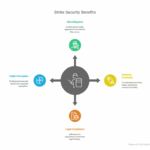Labor strikes are a significant challenge for businesses, especially in sectors where uninterrupted service is crucial, such as healthcare, manufacturing, and public services. When faced with a strike, businesses in Ohio—and indeed across the United States—must swiftly find solutions to maintain operations. This is where strike staffing solutions come into play, providing the necessary workforce to keep the wheels turning.
Understanding the Need for Strike Staffing Solutions
Labor strikes occur when negotiations between employees and employers reach an impasse, often over issues like wages, benefits, working conditions, or job security. During a strike, the regular workforce may stop working, causing significant disruptions to business operations. The longer a strike lasts, the more detrimental it can be to the business’s bottom line and reputation.
In Ohio, a state with a robust manufacturing sector and a growing healthcare industry, the impact of strikes can be particularly severe. For instance, a strike in the healthcare industry could jeopardize patient care, while a strike in manufacturing could delay production and lead to missed deadlines.
To mitigate these risks, businesses often turn to strike staffing agencies that specialize in providing temporary workers who can step in and perform the duties of the striking employees. These agencies offer a range of services, from providing skilled labor to managing the logistics of hiring and deploying temporary staff.
Ohio’s Evolving Labor Force: Understanding Current Trends
Ohio’s labor market has seen significant shifts over recent years, driven by various factors such as technological advancements, economic fluctuations, and demographic changes. As we navigate through 2023, these trends continue to shape the state’s workforce landscape, influencing the dynamics of labor strikes and the need for strike staffing solutions.
Ohio’s Labor Market Dynamics in 2023
Ohio’s labor market in 2023 is characterized by a mix of stability in certain sectors and volatility in others. The state’s unemployment rate has remained relatively low, reflecting a strong demand for workers. However, this overall stability masks underlying challenges in specific industries, particularly in manufacturing and healthcare.
- Manufacturing: Ohio has long been a manufacturing powerhouse, but the sector has faced increasing pressure due to automation, global competition, and shifting supply chains. While some manufacturing jobs have returned to the state, particularly in advanced manufacturing and automotive sectors, the labor force in this industry is aging, leading to a growing skills gap. Strikes in manufacturing are often related to wage disputes and concerns over job security as companies adopt new technologies.
- Healthcare: The healthcare sector in Ohio is growing, driven by an aging population and increasing demand for medical services. However, this growth comes with its own set of challenges. Healthcare workers, particularly nurses, have been vocal about issues such as understaffing, long hours, and insufficient pay. These factors have led to an increase in strike activity, particularly in urban areas with large hospitals.
- Technology and Remote Work: The rise of technology and the increasing acceptance of remote work have also influenced Ohio’s labor market. While this has created new job opportunities, particularly in IT and administrative roles, it has also led to a realignment of workforce expectations. Workers now seek greater flexibility, which has become a sticking point in labor negotiations, leading to potential strike scenarios.
Strike Activity in Ohio: A Growing Concern
Ohio has seen a notable increase in strike activity in recent years, reflecting broader national trends. In 2023, several high-profile strikes have drawn attention to the state’s labor challenges, particularly in sectors like healthcare, manufacturing, and public services.
- Healthcare Strikes: As mentioned earlier, healthcare strikes have become more frequent in Ohio, particularly among nurses and support staff. These strikes are often driven by concerns over patient safety, working conditions, and pay. In some cases, these strikes have led to significant disruptions in services, prompting hospitals to seek out strike staffing solutions to maintain operations.
- Manufacturing Strikes: Ohio’s manufacturing sector has also seen an uptick in strike activity, particularly in the automotive industry. Workers in this sector have expressed concerns over job security, particularly as companies increasingly invest in automation and other technologies. Wage disputes and concerns over working conditions have also been major drivers of strikes.
- Public Sector Strikes: Public sector workers, including teachers and municipal employees, have also been active in Ohio. These strikes are often related to budget cuts, pension disputes, and demands for better working conditions. The public nature of these strikes means they often attract significant media attention, putting additional pressure on both workers and employers.
The Role of Unions in Ohio’s Labor Landscape
Unions have long played a crucial role in Ohio’s labor market, advocating for workers’ rights and negotiating better terms on their behalf. In recent years, however, the role of unions has evolved in response to changing labor market conditions.
- Union Membership Trends: Union membership in Ohio has seen a slight decline, mirroring national trends. However, unions remain a powerful force in the state, particularly in industries like manufacturing, healthcare, and public services. Despite the decline in membership, unions have been successful in organizing strikes and negotiating favorable terms for their members.
- Union Strategies: In response to the changing labor landscape, unions in Ohio have adopted new strategies. This includes greater use of digital tools for organizing and mobilizing members, as well as a focus on issues like healthcare, job security, and wage equality. Unions have also been more willing to strike, particularly in response to what they see as intransigence from employers.
- Impact on Strike Activity: The strength of unions in Ohio has directly contributed to the increase in strike activity. Unions are often at the forefront of organizing strikes, and their involvement can significantly influence the duration and impact of a strike. For businesses, this means that strike staffing solutions must not only address the immediate need for replacement workers but also consider the broader labor relations environment.
Preparing for Future Labor Disputes in Ohio
Given the current labor trends in Ohio, businesses must be proactive in preparing for potential labor disputes. This involves not only understanding the factors driving strike activity but also taking steps to mitigate the impact of strikes on their operations.
- Engaging with Workers: One of the most effective ways to prevent strikes is to engage with workers proactively. This involves regular communication, addressing concerns before they escalate into disputes, and working with unions to negotiate fair terms. By fostering a positive work environment, businesses can reduce the likelihood of strikes.
- Developing Contingency Plans: Even with the best efforts, strikes may still occur. Therefore, businesses should have contingency plans in place. This includes identifying potential strike staffing solutions, ensuring that temporary workers are trained and ready to step in, and preparing for the logistical challenges of deploying a temporary workforce.
- Legal and Compliance Considerations: Navigating the legal landscape of labor disputes can be complex, particularly in a state like Ohio with its own set of labor laws. Businesses must ensure that their actions during a strike, including the hiring of temporary workers, comply with all relevant regulations. This may involve working with legal experts to ensure that all actions are compliant and that the business is protected from potential litigation.
- Leveraging Technology: As discussed earlier, technology can play a crucial role in managing labor disputes. From AI-driven recruitment to real-time tracking of temporary workers, businesses that leverage technology will be better positioned to respond to strikes quickly and efficiently.
Key Considerations When Choosing a Strike Staffing Agency
- Industry Expertise: Not all staffing agencies are created equal. It’s crucial to choose an agency with experience in your specific industry. For instance, healthcare strikes require staff with specific certifications and experience, while manufacturing strikes might need workers with technical skills and safety training.
- Speed and Efficiency: Time is of the essence during a strike. The staffing agency should have the capability to quickly deploy a large number of workers, often within 24 to 48 hours. This requires a vast database of pre-vetted workers and an efficient deployment system.
- Compliance and Legal Considerations: Hiring temporary workers during a strike comes with a host of legal considerations. The staffing agency should be well-versed in labor laws and regulations to ensure that all actions are compliant. This includes understanding the specifics of Ohio’s labor laws and ensuring that temporary workers are treated fairly and legally.
- Reputation and Reliability: A staffing agency’s reputation is paramount. Businesses should look for agencies with a proven track record of successfully managing strike situations. Testimonials, case studies, and references from previous clients can provide valuable insights.
- Customization and Flexibility: Every strike situation is unique. The staffing agency should offer customized solutions tailored to the specific needs of the business. This could include providing workers with specific skills, adjusting the number of workers based on the evolving situation, or even offering additional services like security or logistics support.
The Role of Technology in Strike Staffing
In today’s digital age, technology plays a crucial role in the efficient management of strike staffing. Modern staffing agencies leverage advanced software and platforms to streamline the recruitment, vetting, and deployment process. Here are some technological innovations that are transforming strike staffing:
- AI-Driven Recruitment: Artificial Intelligence (AI) can quickly match the right workers to the right jobs based on skills, experience, and availability. This speeds up the recruitment process and ensures that the temporary workforce is well-suited to the tasks at hand.
- Digital Onboarding: Digital platforms enable the rapid onboarding of temporary workers, including completing paperwork, verifying certifications, and conducting virtual training sessions. This reduces the time between recruitment and deployment.
- Real-Time Tracking and Reporting: Technology allows businesses to track the deployment of temporary workers in real-time. This includes monitoring attendance, performance, and any issues that arise. Real-time reporting ensures that businesses can quickly address any challenges and make informed decisions.
- Remote Work Solutions: For strikes that impact administrative or clerical positions, remote work solutions can be a viable option. Temporary workers can be onboarded and managed remotely, ensuring that business operations continue with minimal disruption.
Challenges in Strike Staffing and How to Overcome Them
While strike staffing is an effective solution, it is not without its challenges. Businesses must be prepared to navigate these challenges to ensure a successful outcome.
- Worker Morale and Public Perception: Bringing in temporary workers during a strike can lead to tension with the existing workforce and negative public perception. It’s important for businesses to communicate transparently with both the public and their employees. Explaining the necessity of temporary staffing to maintain operations and emphasizing that it is a temporary measure can help mitigate negative sentiments.
- Quality of Temporary Workers: The quality of temporary workers can vary, and businesses may face challenges in maintaining the same level of productivity and quality. To overcome this, businesses should work closely with their staffing agency to ensure that the temporary workers are well-trained and closely monitored.
- Legal Risks: Hiring temporary workers during a strike can expose businesses to legal risks, particularly if the strike escalates or if there are disputes over the treatment of workers. To minimize legal risks, businesses should ensure that all actions are compliant with labor laws and that the temporary workers are treated fairly and with respect.
- Cost Considerations: Strike staffing can be expensive, particularly if the strike is prolonged. Businesses must weigh the costs of hiring temporary workers against the potential losses from a halted operation. In some cases, it may be more cost-effective to negotiate with the striking workers to reach a resolution.
Strike Staffing in Ohio
As labor dynamics continue to evolve, the need for efficient and effective strike staffing solutions will only grow. Businesses must stay ahead of the curve by partnering with forward-thinking staffing agencies that leverage technology and have deep industry expertise.
The rise of remote work, the increasing use of AI in recruitment, and the growing importance of compliance and legal considerations will shape the future of strike staffing. Businesses that proactively address these trends and invest in strong partnerships with staffing agencies will be better positioned to navigate the challenges of labor strikes.
Strike staffing solutions are an essential tool for businesses in Ohio, enabling them to maintain operations during labor disputes. By choosing the right staffing agency, leveraging technology, and addressing the challenges head-on, businesses can minimize the impact of strikes and continue to serve their customers.
If your business is facing a potential strike or simply wants to be prepared, consider partnering with a reputable strike staffing agency that understands the unique needs of your industry. With the right support, you can navigate the complexities of labor disputes and keep your operations running smoothly.
For those in need of expert strike staffing solutions, RSS Inc. offers a range of services tailored to meet the demands of your industry. With a proven track record and a commitment to excellence, they can help ensure that your business remains operational during even the most challenging times.










